If you’re looking for help to identify black birds with yellow on their wings, this will be the best article you read today.
In this post, you will find photos, identification info, calls, songs, and all the fun facts you need.
Examples of black birds with yellow on wings include the yellow-winged blackbird, golden-winged cacique, black-and-gold cotinga, yellow-winged cacique, black siskin, and many others.
Here are 22 of the most interesting ones.
Table of Contents
Black Birds With Yellow On Wings
Yellow-winged Blackbird

- Scientific Name: Agelasticus thilius
- Lifespan: n/a
- Wingspan: n/a
Yellow-winged blackbirds are small New World blackbirds found in South America.
They inhabit swamps, intertidal marshes, and pasturelands of Peru, Uruguay, Brazil, Chile, Bolivia, Argentina, and Paraguay.
Male yellow-winged blackbirds are all black with bright yellow shoulders.
Females and immatures have brown plumage with black streaks.
Both sexes have dark eyes, long and squared tails, and dark and pointy beaks.
They usually forage in flocks and look for food along the edge of the water, in shallow marshes, or on nearby drier land.
Yellow-winged blackbirds are omnivores and feed on insects and seeds.
Yellow-shouldered Blackbird
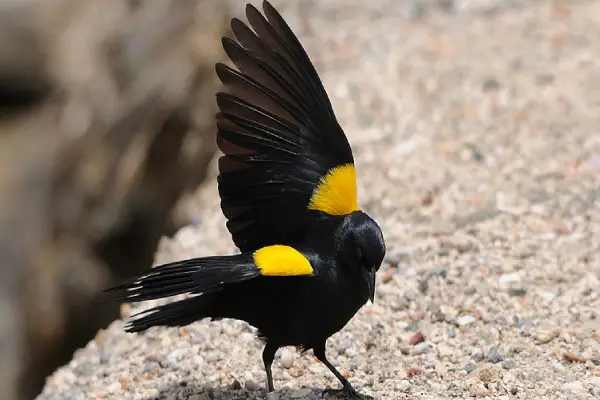
- Scientific Name: Agelaius xanthomus
- Lifespan: 13 years
- Wingspan: n/a
Yellow-shouldered blackbirds are small black birds with yellow on wings native to Puerto Rico.
There, they inhabit coastal mangroves and nearby scrublands.
Males and females look similar and have glossy black plumage with yellow patches on their shoulders; males are bigger than females.
The species is omnivorous and have a diet consisting of mostly insects and some spiders, fruits, and seeds.
Yellow-shouldered blackbirds breed from April to August or February to November which matches with the start of the rainy season. They are monogamous and have a clutch of 1-4 blue-green eggs with brown spots that females incubate.
Yellow-shouldered blackbirds have an interesting way of keeping their feathers groomed.
Scientists observed them grabbing and applying ants to their bodies and feathers; ants secrete formic acid that keeps the birds clean of mites, insects, and different bacteria. This behavior is called anting.
Identify yellow-shouldered blackbirds by their vocalization: rough “chet” and braying “naaah” calls.
Due to several diseases, nest predation, brood parasitism by shiny cowbirds, and loss of habitat, yellow-shouldered blackbirds are now listed as Endangered by the International Union for Conservation of Nature (IUCN).
Red-winged Blackbird
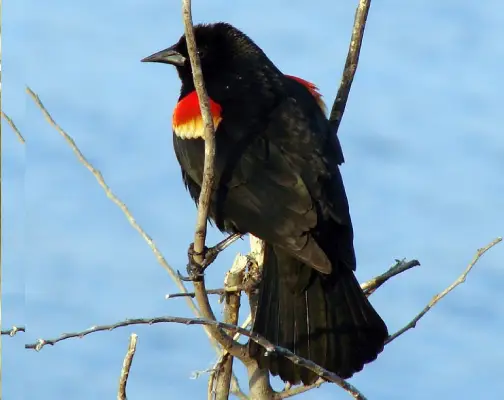
- Scientific Name: Agelaius phoeniceus
- Lifespan: 2 years in the wild
- Wingspan: 12-16 in
Red-winged blackbirds are one of the most common perching birds found in North America.
These tiny songbirds can weigh just 1.46 oz and measure around 6.7 inches in length.
Male red-winged blackbirds have completely glossy black plumage and have wing epaulets that are edged in yellow. They often make shoulder displays and emit rich and scratchy “oak-a-lee” songs.
Females are smaller, streaky brown above, and paler below. They have a scolding chatter that sounds like “chit-chit-cheer-teer-teer-teerr.”
Source: G. McGrane, Public domain, via Wikimedia Commons
Red-winged blackbirds are extremely social birds that love gathering in large flocks during the nonbreeding season – scientists once discovered a flock with over a million birds!
They are also very territorial and polygynous – a single male can have up to 10 different females making nests in his territory. Females, on the other hand, will frequently mate with other males, and lay eggs of mixed paternity.
They will have a clutch of 3-4 pale blue-green eggs with dark streaks.
Red-winged blackbirds are common in habitats with open grassy areas, including wetlands, meadows, prairies, old fields, swamps, agricultural areas, and sparse deciduous forests.
They are omnivores and feed on insects, seeds, and grain.
Attract red-winged blackbirds to your backyard by adding black oil sunflower, hulled sunflower seeds, and mixes that contain corn, peanut hearts, sunflower seeds, and milo to your feeder.
Black Siskin

- Scientific Name: Spinus atratus
- Lifespan: n/a
- Wingspan: 5.1 in
Black siskins are small members of the finch family commonly found in South America.
They inhabit puna grassland with shrubs, rocky slopes, and bogs of Argentina, Bolivia, Chile, and Peru.
Identify male black siskins by their black plumage with yellow bands at their primary feathers and yellow lower bellies and undertails.
Females look similar but have slightly browner upperparts and paler yellow wing patches.
These birds forage in low bushes and on the ground, occasionally in small groups with other seed-eating birds. They are omnivores and mostly consume seeds and some insects.
Identify black siskins by their rapid, loud, and continuous song, “knot-knot” contact calls, and nasal “chio” alarm calls.
They breed from September to November, lay 3-4 bluish-white eggs with gray spots that females incubate, and both parents feed their chicks.
Yellow-rumped Cacique

- Scientific Name: Cacicus cela
- Lifespan: n/a
- Wingspan: n/a
Yellow-rumped caciques are long and slim perching birds found in northern parts of South America.
They inhabit open woodlands, mangrove forests, and cultivated areas with open fields from Panama and Trinidad to Brazil and Peru.
Yellow-rumped caciques have black plumage with bright yellow wing patches, rumps, and undertails.
Recognize them by their pale yellow pointed beaks, and a song that consists of fluting notes with cackles and wheezes; occasionally they might mimic the calls of other birds.
Source: Niels Krabbe, CC BY-SA 4.0, via Wikimedia Commons
These blackbirds with yellow on wings are omnivores and have a diet consisting of insects, spiders, nectar, and fruit.
As part of their courting ritual, males will flap their wings and display their yellow wing feathers.
Females build pouch-shaped nests in tall trees with an active wasp nest around to keep predators away; they will lay 1-3 bluish-white eggs.
They nest colonially, with up to 100 nests built in a single tree.
Golden-winged Cacique
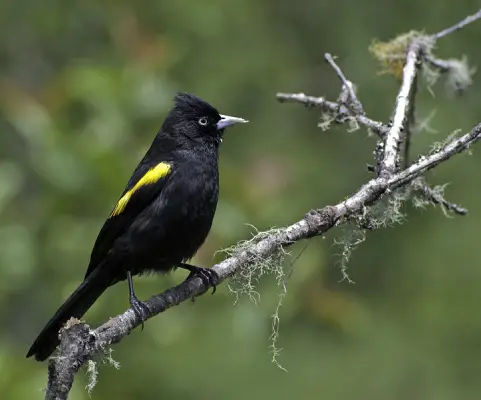
- Scientific Name: Cacicus chrysopterus
- Lifespan: n/a
- Wingspan: n/a
The golden-winged cacique is a New World blackbird with yellow wing patches.
It is common in South America, around humid forests, montane forests, and second growth.
The countries it inhabits are Uruguay, Paraguay, Brazil, Bolivia, and Argentina.
Adults have slightly glossy black plumage with a bright yellow band on lower rumps and on the wings; median wing coverts and inner greater upperwing-coverts are bright yellow and form a conspicuous wing patch.
They also have pale bluish-gray beaks, black legs and feet, and orange, yellow, or blue eyes.
Identify golden-winged caciques by their song consisting of a loud series of notes slowly delivered with a final, loud burst sounding like “cuuk-kaa-prr-whiip-wheeo“.
Pairs will sing in a duet to communicate and strengthen their bond.
Also, listen for their nasal “aa-ah” contact calls and common “charr” calls.
They are omnivores that mostly forage in trees and consume insects, fruits, and nectar.
Golden-winged caciques are monogamous and mate for life. They breed from October to December and have a clutch of 2-4 white eggs with brown spots.
As part of their courting ritual, males will perch with lowered heads, raised bodies and crests, and will expose bright yellow spots on their wings; this is all accompanied by a song.
Yellow-winged Cacique
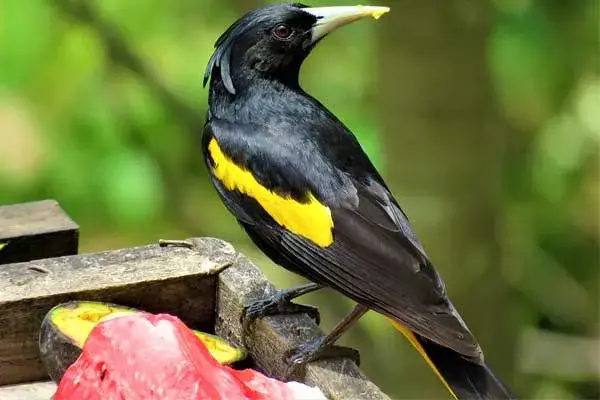
- Scientific Name: Cassiculus melanicterus
- Lifespan: n/a
- Wingspan: n/a
Yellow-winged caciques are also known as Mexican caciques.
These spectacular and remarkable-looking black and yellow birds are found in humid forests, montane forests, and the second growth of west Mexico and Guatemala.
Yellow-winged caciques have black plumage, bright yellow rumps, and a large yellow patch on their inner wings.
Their tails are striking yellow, except for the central rectrices (the larger feathers of the tail) that are black; on their heads, there are long crests that flop around as the birds move.
Yellow-winged caciques are large members of the blackbird family that are usually found in flocks.
These birds are polygynous (males mate with multiple females) and the females are responsible for building the nest, incubation, and caring for the young – the males take no part in raising chicks.
Yellow-winged caciques are omnivorous and have a diet consisting of insects, fruit, and some nectar and seeds.
The species is rather loud and have a song that begins with various liquid notes and is followed by a sound that resembles a rusty door being opened.
Mountain Cacique
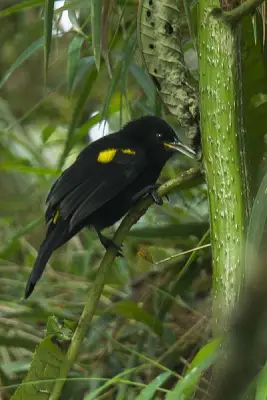
- Scientific Name: Cacicus chrysonotus
- Lifespan: n/a
- Wingspan: n/a
Mountain caciques are striking black-and-yellow birds found in subtropical or tropical moist montane forests of South America.
They are common in Venezuela, Peru, Ecuador, Colombia, and Bolivia.
There are two subspecies, the northern and southern mountain caciques.
Northern mountain caciques are all-black with broad yellow wing patches and bright yellow rumps; the southern population lacks such patches.
These birds are usually found in pairs or small flocks and might form groups with jays or tanagers.
Source: Niels Krabbe, CC BY-SA 4.0, via Wikimedia Commons
Mountain caciques are omnivores that feed mostly feed on insects and other arthropods, and some fruits and nectar.
Golden-tufted Mountain Grackle
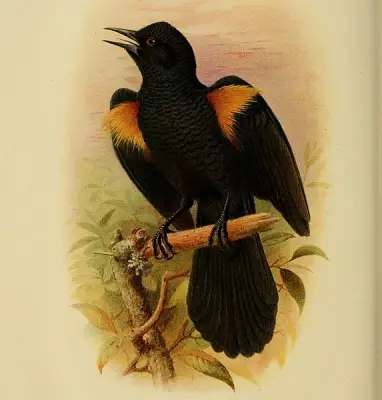
- Scientific Name: Macroagelaius imthurni
- Lifespan: n/a
- Wingspan: n/a
Golden-tufted mountain grackles are medium-sized blackbirds found in subtropical or tropical moist montane forests of Venezuela, Guyana, and Brazil.
Also known as golden-tufted grackles and Tepui mountain-grackles, these slim birds with long tails are all black and have yellow tufts at the bend of their wings.
They can be rather noisy and make various sounds: identify them by their squeaking and chickling calls.
Golden-tufted grackles resemble epaulet orioles, another stunning species on our list of black birds with yellow on wings. The main differences include grackles’ thicker beaks, yellow in their pectoral tufts (orioles have yellow on their shoulders), and their stockier bodies.
Golden-tufted mountain grackles are omnivores that mostly feed on insects and fruit.
Regent Bowerbird
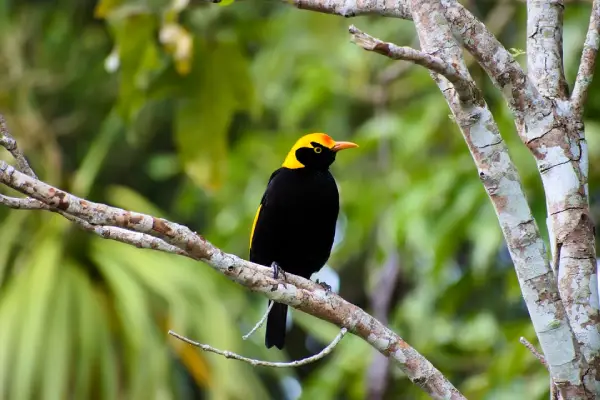
- Scientific Name: Sericulus chrysocephalus
- Lifespan: 20-30 years
- Wingspan: n/a
Regent bowerbirds are medium-sized birds native to Australia.
They inhabit rainforests and leafy coasts of eastern Australia, all the way up to central Queensland.
Their name commemorates the prince regent of the United Kingdom.
Incredibly beautiful and intelligent, male regent bowerbirds are black with stunning bright golden yellow on their wings, mantles, and heads.
Females have more dull, speckled brown, gray, and olive colors.
Male regent bowerbirds are known for building ground structures called bowers to attract females.
They will decorate their bowers with colorful objects, different types of fruits, snail shells, and pieces of blue plastic.
Males will also mix a muddy greyish blue or pea green “saliva paint” in their mouths and use it to decorate their bowers.
Some authors claim that these birds sometimes use bundles of leaves to apply the paint which would be one of the few uses of tools in birds. However, this idea has recently been criticized.
Males are polygynous, they will mate with several females and then let them build the nest and raise the chicks alone.
Regent bowerbirds are omnivores and feed on fruits, berries, and insects.
Puerto Rican Oriole
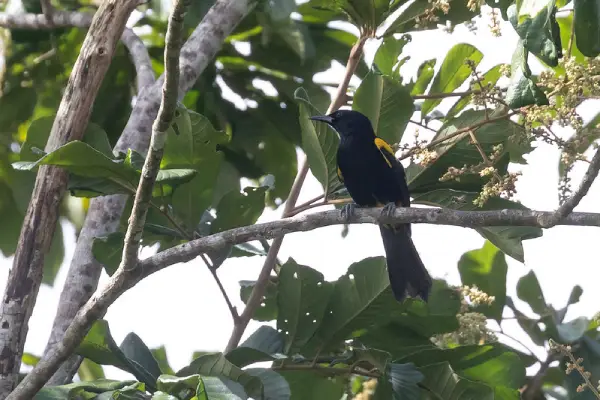
- Scientific Name: Icterus portoricensis
- Lifespan: n/a
- Wingspan: 3.8 in
Puerto Rican orioles are small birds endemic to Puerto Rico.
They inhabit tropical forests, mangrove forests, and plantations, and nest in palm trees.
Puerto Rican orioles are black and have yellow on their shoulders and lower bellies; their lesser and median upperwing coverts form a conspicuous yellow wing epaulet.
Identify them also by their song consisting of high-pitched whistles. They will also make buzzy “zzwhi” and “tchu” calls.
Puerto Rican orioles are monogamous and stay together for life. They breed from February to July and lay 2-3 whitish-blue eggs with gray-brown spots.
Their nests might be parasitized by shiny cowbirds (cowbirds will lay their eggs in orioles’ nests for them to raise cowbird chicks).
They are omnivores and feed on insects, spiders, lizards, frogs, seeds, nuts, and fruit.
St. Lucia Oriole
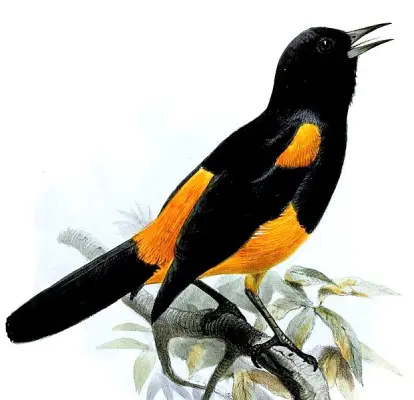
- Scientific Name: Icterus laudabilis
- Lifespan: n/a
- Wingspan: 3.7-3.9 in
Saint Lucia orioles are slim and long-billed birds endemic to Saint Lucia, an island country located in the eastern Caribbean Sea.
They inhabit woodlands, especially those with palms.
Male Saint Lucia orioles are black with orange-yellow bellies, shoulders, and rumps; females have slightly duller yellow wing patches.
These birds are omnivores and feed on insects and fruits, stripping bark when foraging.
Identify them also by their rapid song consisting of a series of whistles and squeaks; they also have harsh “chwee” and soft “chup” calls.
Saint Lucia orioles nest from April to June, build basket-shaped nests under large fronds of banana plants and in coconut palms and lay 2-3 white and brown spotted eggs that females incubate. They are a monogamous species.
Due to increasing habitat loss, parasitism by shiny cowbirds, and the use of pesticides, their population has been on the decline.
IUCN has listed Saint Lucia orioles are Endangered and scientists estimate a total population of slightly over 1,000 birds.
Variable Oriole
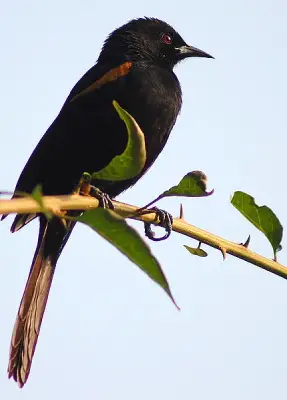
- Scientific Name: Icterus pyrrhopterus
- Lifespan: n/a
- Wingspan: n/a
Variable orioles are long and slender blackbirds with long tails and straight dark beaks.
They are commonly found in woodlands, open forests, second growth, parks, gardens, and urban areas of Uruguay, Paraguay, Brazil, Bolivia, and Argentina.
Variable orioles are completely black birds with yellow-orange on their wings and thighs.
They have a fast and variable song and might even include songs and calls of other birds.
Variable orioles are herbivores that mostly feed on fruits. They forage in trees, often hanging upside-down while eating.
Variable orioles are considered monogamous species that breed from October to January.
They do not nest in colonies and build globe-shaped nests using fine plant fibers; during the non-breeding season, they might be seen in flocks with different birds.
Epaulet Oriole
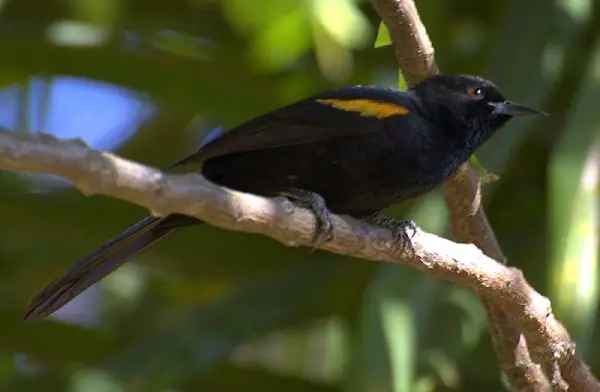
- Scientific Name: Icterus cayanensis
- Lifespan: n/a
- Wingspan: n/a
Epaulet orioles are small and slender birds found in South America.
They inhabit lowland rainforests, swamps, shrublands, and heavily degraded former forests of Suriname, Peru, Guyana, Ecuador, Colombia, Brazil, and Bolivia.
Epaulet orioles are all black with golden-yellow on their wings; northern populations known as Moriche orioles also have golden hoods and rumps.
They are thought to be monogamous, males sing to attract females, and can be often seen alone or in pairs.
Source: Niels Krabbe, CC BY-SA 4.0, via Wikimedia Commons
Epaulet orioles are omnivorous and feed on insects, fruit, and nectar; often hanging from vines and flicking their tails as they forage.
Golden-crested Myna

- Scientific Name: Ampeliceps coronatus
- Lifespan: 15-20 years
- Wingspan: n/a
Golden crested mynas are conspicuous birds with glossy black plumage, bright yellow wings and heads, and pale yellow-orange beaks.
The word “myna” means “bubbling with joy”, coming from a Sanskrit “madana” meaning joyful or delightful, which is derived from the root word meaning “bubbles.”
Golden-crested mynas mainly inhabit subtropical or tropical moist lowland forests but can be also found in heavily degraded former forests.
They are common in north-eastern India and Indochina.
These birds mostly feed on insects and fruits, sometimes on small fish and lizards.
Golden-crested mynas nest in holes and tree cavities and lay a clutch of 3-5 eggs that hatch after approximately 3 weeks.
Read More: More examples of black birds that have yellow heads
Yellow-mantled Widowbird
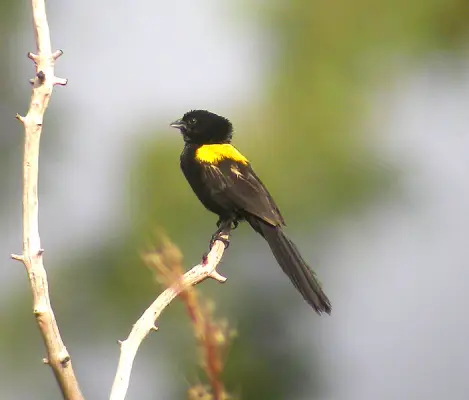
- Scientific Name: Euplectes macroura
- Lifespan: n/a
- Wingspan: n/a
Yellow-mantled widowbirds are also known as yellow-backed widows and can be found throughout Africa.
They are common around open habitats, including cultivation, moist grasslands, marshes, and forest clearings.
Scientists recognize 3 subspecies of the Yellow-mantled widowbirds.
Male yellow-mantled widowbirds are black and have yellow on their shoulders and long tails; some populations might also have completely yellow backs.
Females and non-breeding males are brownish with streaks; males keep the yellow in their wings year-round.
Identify them by a song consisting of a series of harsh “zhet” notes that males emit while flying.
Yellow-mantled widowbirds are omnivores and feed mostly on seeds and some insects like termites.
Yellow-mantled widowbirds are polygynous, a male will mate with up to five females, and can be very territorial.
Their breeding season varies from region to region, their nests are large oval structures with a side entrance, and females lay 2-3 pale green eggs with brown spots.
Montane Widowbird
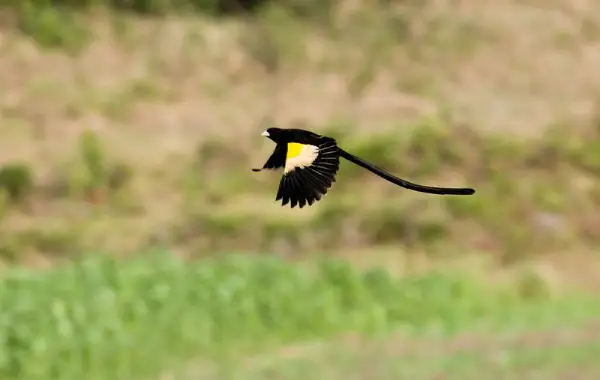
- Scientific Name: Euplectes psammacromius
- Lifespan: n/a
- Wingspan: n/a
Montane widowbirds, also known as mountain marsh widowbirds, are black birds with yellow on wings found in Africa.
They inhabit montane marshes, heaths, and grasslands of Zambia, Malawi, and Tanzania.
Similar to other widowbird species, plumage varies between seasons.
Breeding males are all-black with yellow shoulder patches and long tails; non-breeding males and females are streaked and brown, although males keep their colorful shoulders.
Identify montane widowbirds by their low raspy and sizzling calls.
They are omnivores and feed on seeds and insects.
Montane widowbirds are territorial and considered polygynous species.
They build dome-shaped nests using grass and females lay 2 pale olive-green eggs with brown spots and streaks.
Montane widowbirds tend to form larger flocks during the non-breeding season.
Males resemble marsh widowbirds – the main difference is their more extensive buff shoulder patches.
Marsh Widowbird
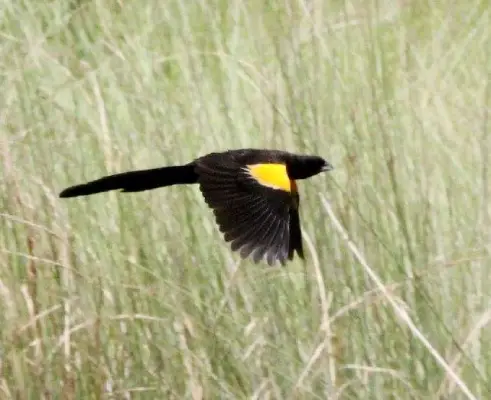
- Scientific Name: Euplectes hartlaubi
- Lifespan: n/a
- Wingspan: n/a
Marsh widowbirds are also known as Hartlaub’s widowbirds.
These large widowbirds are commonly found in swampy grasslands and nearby cultivated areas throughout Africa.
They breed in marshes and have a clutch of 1-3 greenish-blue eggs with olive-gray spots.
Breeding male marsh widowbirds have long tails, black plumage, and yellow-orange wing patches.
Females and non-breeding males are brown and streaky; males keep their yellow spots on the wings.
Marsh widowbirds can be also identified by their low rasps and twittering and sizzling calls. Their song consists of short, rising “grrreeng” notes, followed by high-pitched “chritterwee” buzz or trill.
They are omnivores that feed on seeds, insects, and small fruits.
They usually forage in small groups, often with other widowbirds.
Black-and-gold Cotinga
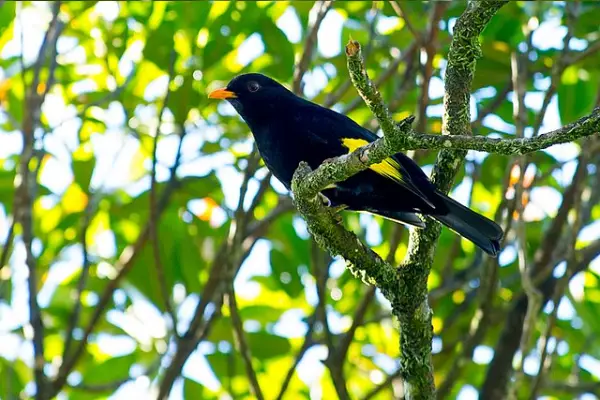
- Scientific Name: Lipaugus ater
- Lifespan: n/a
- Wingspan: n/a
Black-and-gold cotingas are birds endemic to south-eastern Brazil.
They are sexually dimorphic species, males and females look different.
Male black-and-gold cotingas have black plumage contrasting with striking yellow color on their wings (on flight feathers called remiges).
Females are olive-green; both sexes have short orange beaks and small red eyes.
They can be identified by their song which is a long sharp and high-pitched whistle.
These birds inhabit highlands at elevations ranging from 3,900 to 6,700 ft.
Black-and-gold cotingas are omnivores and have a diet consisting of fruits and some insects.
Read More: More examples of birds that have orange-colored beaks
Yellow Bishop

- Scientific Name: Euplectes capensis
- Lifespan: up to 9 years
- Wingspan: n/a
Yellow bishops are known under several names, including Cape bishops, Cape widows, and yellow-rumped widows.
They are commonly found in Africa and inhabit grasslands, open woodlands, heathlands, and areas with cultivation.
These stocky birds measure 5.9 inches in length and weigh 0.67-1.3 oz.
Breeding yellow bishops are black with bright yellow in their rumps, lower backs, and shoulder patches; they also have short crests, short tails, and thick conical dark beaks.
Females and non-breeding males are streaky brown but males get to keep their yellow patches.
During breeding season these black birds with yellow on wings can be seen alone or in pairs, but when the non-breeding season comes, yellow bishops mix with other birds and form large flocks.
Identify them by their “zeet-zeet” and harsh “zzzt” calls. Their song consists of simple twitters and sizzling notes.
Yellow bishops are omnivores and have a diet consisting of seeds, grain, and insects.
Golden-winged Manakin

- Scientific Name: Masius chrysopterus
- Lifespan: n/a
- Wingspan: n/a
Golden-winged manakins are small birds found in South America.
They inhabit moist montane forests and heavily degraded former forests of Venezuela, Peru, Ecuador, and Colombia, at elevations ranging from 2,600 to 6,500 feet.
Males are jet black with yellow-golden wings (best seen when flying), forecrowns, and black horns.
Females have olive-green plumage with yellowish bellies and throats and dull pinkish beaks and legs.
Although mostly quiet, golden-winged manakins will make several vocalizations.
Males will most commonly make a single, low, buzzy note. When displaying, they will make a more complex series of high, thin calls and rapid buzzes, followed by sputtering and snapping noises.
Source: Niels Krabbe, CC BY-SA 4.0, via Wikimedia Commons
Golden-winged manakins are omnivores and feed on small fruits, berries, and insects.
Hispaniolan Oriole

- Scientific Name: Icterus dominicensis
- Lifespan: n/a
- Wingspan: n/a
Hispaniolan orioles are small black birds with white on wings that are endemic to the island of Hispaniola in the Caribbean.
Hispanional orioles have black plumage and distinctive yellow patches on their wings, rumps, and undertails.
Identify them by their song consisting of squeaky and metallic notes; their calls are buzzy “jrrt” and a metallic “zhwee“.
They inhabit forests, forest edges, woodlands, and gardens of the islands of Hispaniola, Gonave, Saona, and Tortuga.
The species are omnivorous and feed on fruits, insects, nectar, and flowers; they will hang upside-down to grab food and can be seen foraging in dense vegetation.
Hispaniolan oriole breed from March to June, build their nests on the underside of banana trees or palm fronds, and lay 3 whitish eggs with brown spots.
Read More: Examples of black birds that have long beaks
Summary
This concludes our list of black birds with yellow on wings.
Examples of yellow-winged black birds include several types of blackbirds, widowbirds, orioles, caciques, siskins, etc.
Hopefully next time you see these birds, you will recognize any of them with ease!
And if you enjoyed our article, here are our other popular reads on birds: Black birds that have orange on their beaks and List of black birds with white bellies